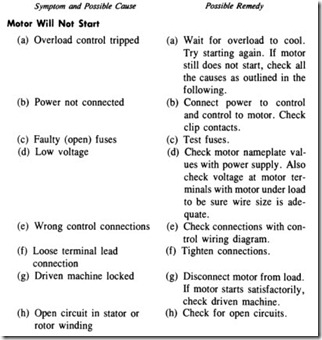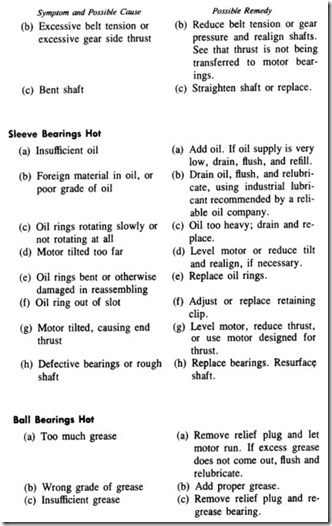SQUIRREL-CAGE MOTOR TROUBLE CHART
SUMMARY
The squirrel-cage motor is the most common form of induction motor. The motor derives its name from the fact that the rotor, or secondary, resembles the wheel of a squirrel cage.
A squirrel-cage motor consists essentially of a stator (or primary and a rotor (or secondary). The stator consists of a laminated sheet-steel core with slots containing the insulated coils. The coils are so grouped and connected to produce a rotating magnetic field when connected to a polyphase alternating-current circuit.
The rotor is also constructed of steel laminations, but the windings consist of conductor bars placed approximately parallel to the shaft and close to the rotor surface. These windings are short-circuited, or connected together at each end of the rotor, by a solid ring.
The squirrel-cage (or secondary) winding takes the place of the field winding in the synchronous motor. As in a synchronous motor, the currents in the stator set up a rotating magnetic field which is produced by increasing and decreasing currents in the windings. When the current increases in the first phase, only the first winding produces a magnetic field. As the current decreases in the first winding and increases in the second, the magnetic field shifts slightly, until it is all produced by the second winding. When maximum current is flowing in the third wind ing, the field is shifted a little more. The windings are so distributed that the shifting is uniform and continuous, which produces a rotating magnetic field.
The speed of a squirrel-cage motor is nearly constant under normal load and voltage conditions, but is dependent on the number of poles and frequency of the ac source. This type of motor slows, however, when loaded barely enough to produce the increased current for the required torque.
The starting torque of a squirrel-cage induction motor is the turning effort or torque which the motor exerts when full voltage is applied to its terminals at the instant of starting. The amount of starting torque depends, within limits, on the resistance of the rotor winding, and it is usually expressed as a percentage of full-load torque.
The squirrel-cage motor is simple in construction and can be built to suit almost any industrial requirement; therefore, it is one of the most widely used machines. As a rule, squirrel-cage motors are not suitable where high starting torque is required, but they are most suitable for medium or low-starting-torque requirements.
REVIEW QUESTIONS
1. What are the two basic units in a squirrel-cage motor?
2. What is the basic operating principle of the squirrel-cage motor?
3. What is the basic difference between the synchronous motor and the squirrel-cage motor?
4. How is starting torque expressed?
5. Why is the squirrel-cage motor used widely in industry?
6. List five industrual applications for the squirrel-cage motor.




